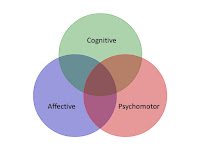When working with students to write performance objectives, specifically when we apply the Domains of Learning; Cognitive, Psychomotor, and Affective to those objectives; we find that most students have an easier time with Psychomotor than with Cognitive or Affective. I have worked over the years to understand why this might be in an effort to better help my students understand how to apply the domains to performance objectives. Recently, I’ve had an insight.
There is also what I’ll call a “human element” at play. I can watch someone do a task and relatively easily measure how well they do it. As an example, run a 5k in less than 30 minutes; this is relatively easy to measure. The Psychomotor domain is quite literally, right in front of you.
However, to know what a student thinks, I must ask them to explain those thoughts. And then, even in the best circumstances there are unconscious biases within each of us and a student’s desire to have the correct answer that get in the way of good measurement. These things make the Cognitive domain less accessible to us as instructors. The same issues seen in the Cognitive domain get in the way when we try to access and measure a performance in the Affective domain.
All of that is fairly straightforward. My insight is about how we visually represent this:
The domains are often drawn as a Venn diagram, or if dealing with Bloom’s levels for each domain they are often drawn as separate triangles. But both of these visual representations seem to miss something.
We have often described to students that when you look at the Venn diagram of the domains, the circles don’t actually pull apart. At any time, during any performance, the student exists in all three domains. It is the trainer’s efforts to focus on one domain that is represented by pulling the rings partially apart.This description paired with the Venn diagram visual doesn’t seem to assist our students in understanding very well. So, for a while I would draw the three circles over the top of each other. I would describe how the Psychomotor was visible, it sat on top, and was easier to see how to describe and measure performance. Cognitive required explanation through verbalization, a Psychomotor task, to be measured and for the reasons I’ve already stated is more difficult to be certain about. Affective then “hid” behind both of these, requiring an explanation or a visible activity to see the effects of the value of the student.
This, maybe, helped some students.
Recently, I have taken to drawing this “stack” of the domains from the side. First we need to recognize that as an instructor, we have one perspective when observing another’s performance. This is represented by the gray arrow pointing down in the diagram to the right.
The only visible portion of our student is the Psychomotor domain. Both of the other domains are expressed through this domain. Set inside the Psychomotor domain is the Cognitive domain. As stated previously, this domain has to be expressed through some Psychomotor means, speaking or writing, etc. This is represented by the green arrow pointing up in the diagram.
The Affective domain sits inside both of the other domains. It must be expressed either by a Psychomotor performance, “…enter the room without hesitation…” or through an explanation, “…state why you made the choice…”. This is represented by the blue arrow pointing up in the diagram.
This nested doll visual of the domains seems to better depict how a performance objective draws out a student’s state in each domain.
Now, as I stated above, Psychomotor seems to be the easiest of the three to see and measure. But we need to recognize that measurement in this domain doesn’t tell us very much about our student. Most of the really important stuff occurs in the other domains. Just because a student can physically make a weapon work well, hitting the target with every shot, doesn’t tell us anything about their attitudes regarding overall safety, the use of violence, the appropriate use of the weapon, etc. All of that information is found in the other domains.
We’re also pretty good at lower-level Cognitive measurement; often done by asking our students to recognize some piece of information in a multiple-guess type question. But that isn’t how we use the information in our real work situations. Which is a discussion for a later post, really.
Ultimately, the Affective domain is the domain that drives all of our performances. Why we act or don’t act, why we make one choice over another, why we prioritize, learning to make a choice when there isn’t a “right” choice to be found. These skills, these values have the greatest association to a successful law enforcement officer who increases the value of their profession and works to create a safe and sustainable society.
Will


